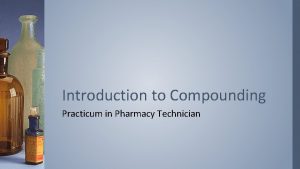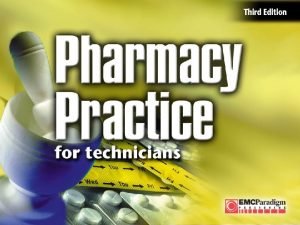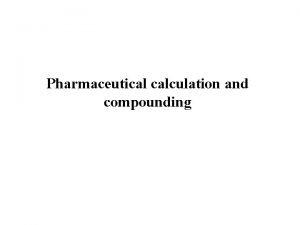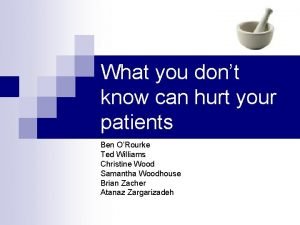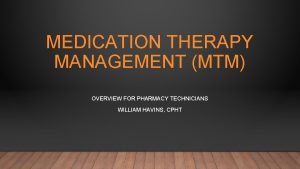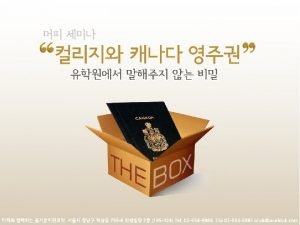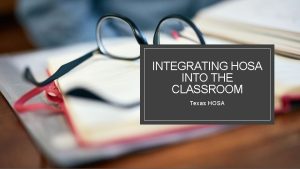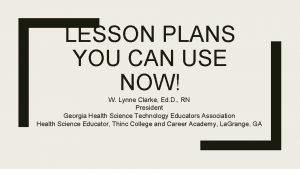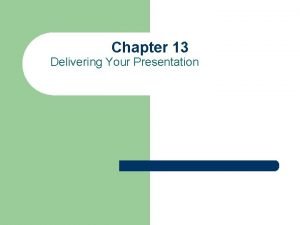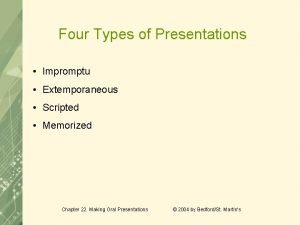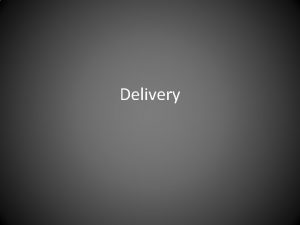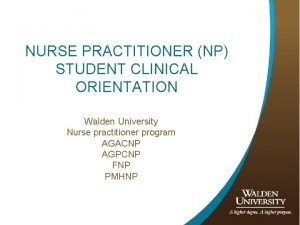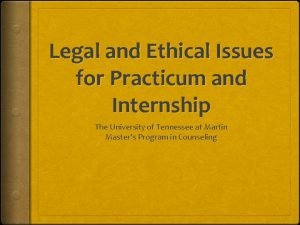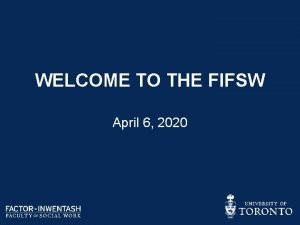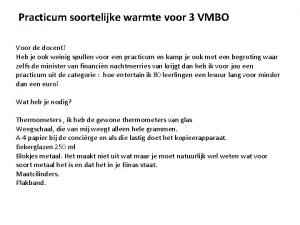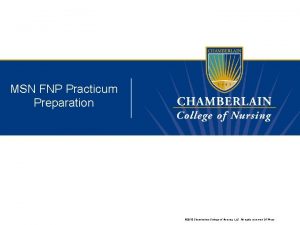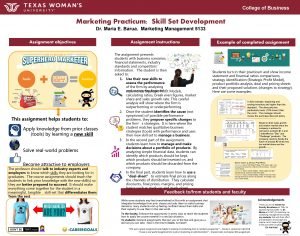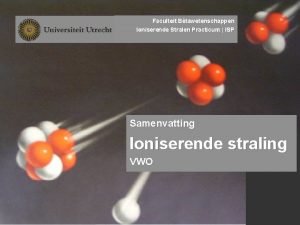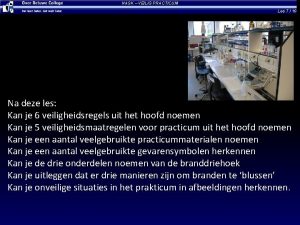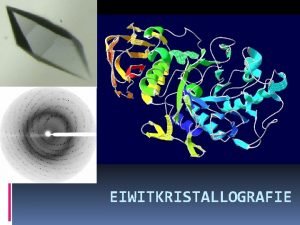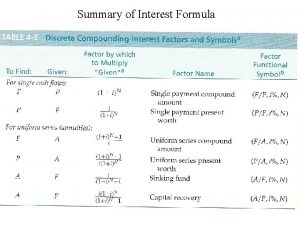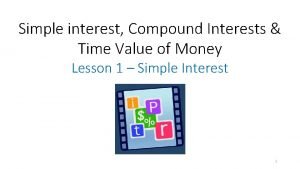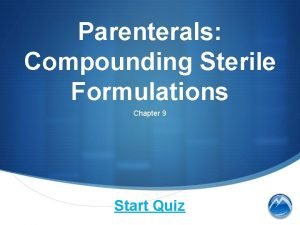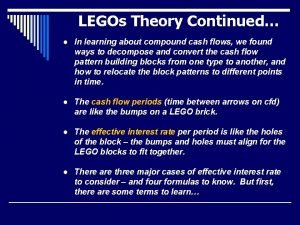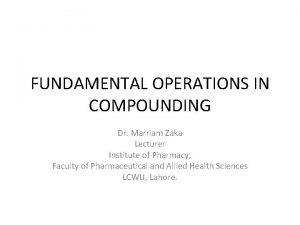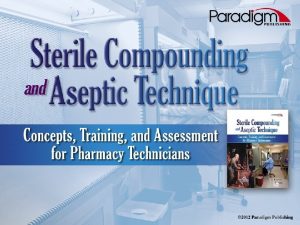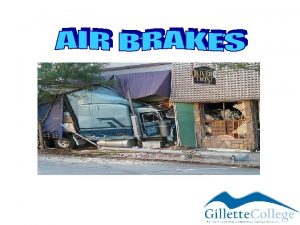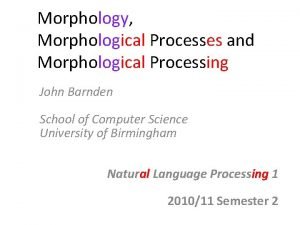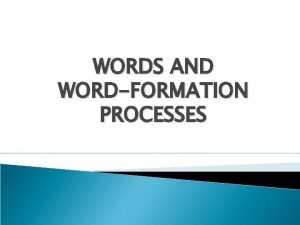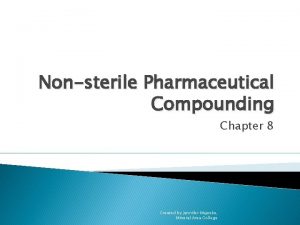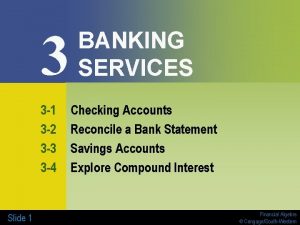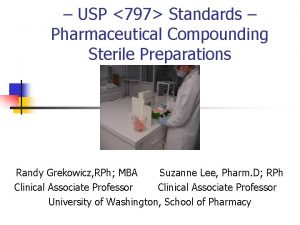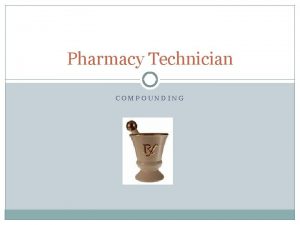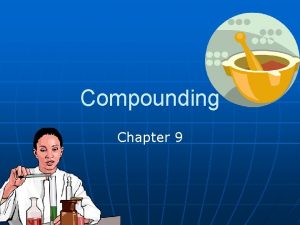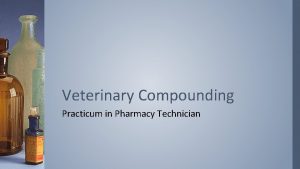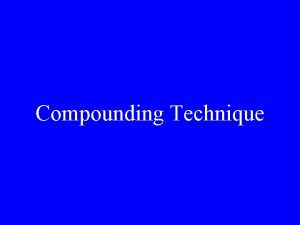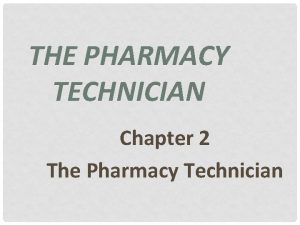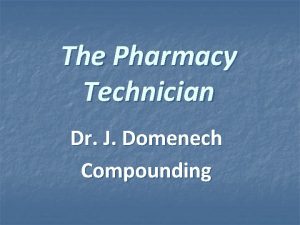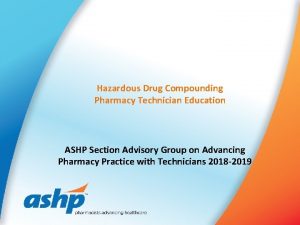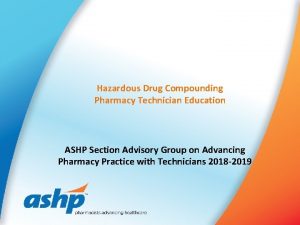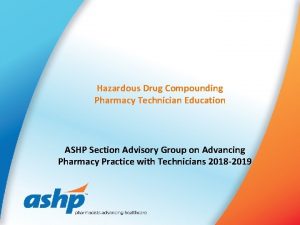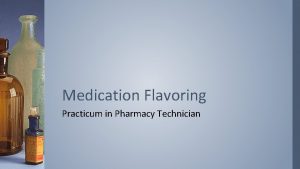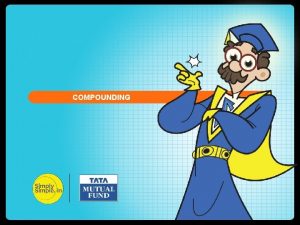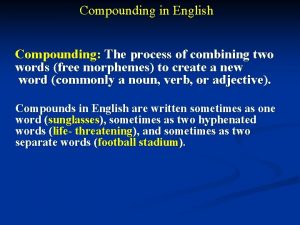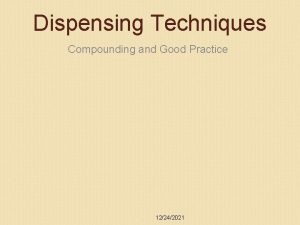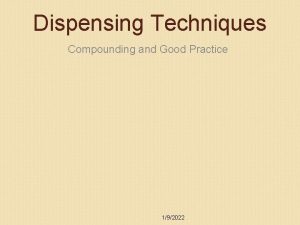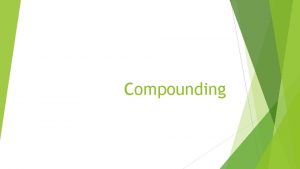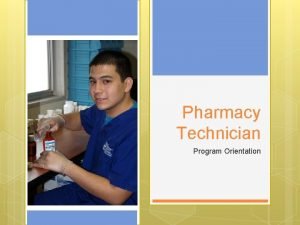Introduction to Compounding Practicum in Pharmacy Technician EXTEMPORANEOUS





































- Slides: 37

Introduction to Compounding Practicum in Pharmacy Technician

EXTEMPORANEOUS COMPOUNDING § Compounding – to produce or mix by combining two or more parts. § Extemporaneous Compounding – the timely preparation of drug product according to a physician’s prescription, a drug formula, or a recipe in which the amounts of the ingredients are calculated to meet the needs of a particular patient or group of patients.

EXTEMPORANEOUS COMPOUNDING § It can be as simple as combining two topical ingredients to create a preparation. § In other cases, compounding will be an extensive and complex procedure of combining more than one active ingredient with several excipients to produce a desired product. § Excipient – any more or less inert substance added to a prescription in order to confer a suitable consistency or form of the drug; a vehicle.

Why is Pharmaceutical Compounding Increasing? 1. 2. 3. 4. 5. Limited number of dosage forms Limited number of drug strengths Shortages of drug products and combinations New therapeutic approaches Special patient populations

Types of Compounds § There are several common dosage forms that can be prepared by a compounding pharmacy. • • • Capsules Liquids Transdermal Gels Creams Ointments Suppositories Troches Tablets Capsules Liquids Lollipops Medication Sticks

Types of Compounds § The form chosen will depend on: – How the prescription is ordered – The physical properties of the drug being ordered; research must be done to ensure compatibility of the active ingredients and excipients – The best route of administration according to the individual patient – The availability of the active ingredient and excipients

Patient Considerations › For complete patient care, many factors must be taken into consideration, the most important being the patient. › It is imperative to get to know the patient so that the appropriate dosage form can be offered to ensure compliance and patient safety. › A complete patient profile must be collected which includes: – Allergies – Sensitivities – Conditions

Patient Considerations § Pediatrics • Drugs may only be available in an adult formulation and may require compounding. • Drugs may be compounded into a liquid, topical cream, transdermal gel, or suppository. • Patients with a gastrotube or naso gastrotube require medications in liquid form. • Children with disabilities may be difficult to treat with oral medications so drug may be compounded into a topical. • Current protocols may call for medications without preservatives.

Patient Considerations § Terminally Ill Patients § Many terminally ill patients are unable to swallow oral medications. § Compounding multiple medications into one dosage form, reducing the number of doses to be given. § Cancer patients develop sores in their mouth that can be medicated with a lozenge or lollipop. § May want to avoid metabolism by the liver.

Patient Considerations § Veterinary Medicine § Offers solutions to veterinarians and pet owners. § Many animals are nearly impossible to dose orally. § Unique dosage forms can be compounded to reduce stress and anxiety and provides better compliance. § Weight is the determining factor when prescribing medications for animals. § Drugs that must be given orally can be compounded with flavoring such as beef, chicken, tuna, or liver. § Medicated flavored chewable are popular. § Rectal suppositories can be given during a seizure. § Transdermal gels can be applied to a hairless area on the animal, such as the pinae of the cats ear or the groin area of a dog.

Compounding Considerations § Every prescription that presents itself as a potential compound requires at least a minimum amount of information be gathered. § Patients Medical Profile – allergies, sensitivities, conditions § It must be determined that the drug can in fact be compounded into a quality effective product. § Cost effectiveness § Best choice for patient § Interactions with patient, active ingredient, and excipients. § Stability – final products environment (aqueous, fixed oil, alcohol), p. H of final product (flavoring) § Solubility – may require a suspending agent § Shelf Life – how long the product is stable until decomposition § Storage – refrigeration, room temperature, protected from light

Facilities, Equipment, and Supplies Practicum in Pharmacy Technician

Facilities, Equipment, Calculations and Formulas › Compounded prescriptions require a number of calculations, a formula or recipe, equipment and supplies, and an area suitable for compounding.

Calculations › Most compounded prescriptions require calculations as part of the process for filling the prescription. › This area has the greatest potential for error. › Although most pharmacy math is relatively simplistic, something as minor as a misplaced decimal can have devastating results, including death.

Calculations › Tingle Lips Medicated Lip Balm – – – Menthol 1% Camphor 1% Glycerin 3% White Wax 16% Peppermint Oil 2% White Petrolatum QS 60 g

Calculations › Insect Bite Ointment – – – Zinc Oxide Calamine Camphor Glycerin White Petrolatum 12% 16% 1% 18% QS 30 g

Formulas › A formula or recipe for each compounded prescription must be prepared by a pharmacist or a physician. › From this formula a worksheet is created. › Can be done by hand or on the computer. › Every step should be written out so that it is absolutely clear how the compound is made.

Formulas › Nothing should be left to be assumed. › No abbreviations should be used when listing ingredients. › Every quantity should be followed by the appropriate unit of measure. › Ditto marks are not acceptable. › Any amount listed as less than a whole number should be expressed with a leading zero. For example, . 1 grams should be written as 0. 1 grams.

Traditional Equipment › Class A Prescription Balance – balance scale that has a sensitive balance range of 6 mg with a maximum capacity of 120 g.

Traditional Equipment › Triple Beam Balance – single pan instrument with an unequal arm that acts as a compound lever; used for weighing large amounts.

Traditional Equipment › Counter Balance – a double pan balance capable of weighing large quantities; not intended for measuring small weights.

Traditional Equipment › Spatulas – used to transfer solid ingredients to weighing pans. They are also the preferred mixing instruments with semisolid forms such as creams and ointments.

Traditional Equipment › Weighing Papers – used to weigh powders and other solid and semisolid pharmaceuticals to prevent contamination or damage to the weighing pans.

Traditional Equipment › Mortar and Pestle – used to grind and/or triturate crystals and large particles into fine powders.

Traditional Equipment › Ointment Slabs – large plates that provides a hard non absorbable surface for mixing compounds.

Traditional Equipment › Graduates – container marked with calibrated measurements used for liquids. › Meniscus – the shape of the outer surface of a liquid, it can be a concave or a crescent shape, which is caused by surface tension. › The correct reading is the mark at the bottom of the meniscus. › When reading liquids, they must be viewed at eye level, sitting on a level surface.

Modern Equipment › Electronic Balance – a digital weighing balance scale. – Taring – the process of resetting an electronic balance to a zero reading once weighing paper or boat has been added to the balance. – Can also tare between chemicals.

Modern Equipment › Mini Ointment Mill – allows the incorporation of solid and semi solid ingredients into a cream, gel, and ointment bases by milling the active ingredient to minute particle size and efficiently incorporating and dispersing the active ingredient throughout the base.

Modern Equipment › Thermostatic Controlled Hot Plate with Magnetic Spinners – this combination allows semisolids and liquids to be heated and stirred at the same time. – The speed of the magnets are controlled by a rheostat.

Modern Equipment › Electronic Mortar and Pestle (EMP) – motorized piece of equipment used to combine multiple ingredients into ointment, gel, and cream bases. – The EMP saves processing time because not only can it be set to operate by itself, but it is able to produce a large quantity of product in one single operation.

General Compounding Practices › Active ingredients should be collected and placed to the right of the scale. › As each ingredient is weighed, the stock bottle should then be moved to the left of the scale. › As each ingredient is weighed, the technician should check the label to the worksheet. › The weights of the ingredients should be checked by a pharmacist while they are still on the scale.

Expiration Dates › Compounded liquids in a fixed oil should be stored at room temperature with an expiration date of six months. › Aqueous solutions should have an expiration date of 14 days when stored at a cold temperature. › Non aqueous liquids and solid formulations made with USP grade chemicals should have an expiration date of no longer than 6 months. › All other preparations should have an expiration date of 30 days or the intended duration of therapy, whichever is earlier.

Facilities › The compounding facility, or laboratory, should be designed in such a way that work processes flow easily and the highest quality products are produced. › The compounding area should be separate from all other work flow. › The area should be well lit, ventilated, and have a controlled temperature. › Equipment should be easily accessible. › Surfaces should be made of material that will not retain dust, odors, or stains. › Surfaces should be smooth, level, and free of cracks or crevices.

Cleaning › All surfaces and equipment should be cleaned before and after use during compounding to avoid cross contamination. › Cross contamination – when bacteria or particulates migrate to an undesired space and have the potential to cause harm. › The entire compounding area should be cleaned either daily or weekly. › One appropriate cleaning solution is 70% Isopropyl Alcohol. › Must have an adequate sink with hot and cold water.

Disposal › Trash containers should be kept at a distance from the compounding procedures. › Trash should be removed from the facility daily. › Any PPE or supplies that have been contaminated with a dangerous or hazardous substance should be placed in a zipper back before disposal. › Hazardous waste should not be disposed of in regular trash, but in a biohazard waste container.

Storage Equipment › Items that are commonly used in most procedures should be stored in an area that is easily accessible to each station. › If needed, Items may be duplicated in more than one place. › Storage should be located out of the way of traffic so multiple preparers wont be interrupting on another. › Any supplies with an opening should be stored upside down. › Instruments should be stored in covered storage such as drawers.

Storage Ingredients › Drugs, chemicals, and excipients should be stored alphabetically and separated by class. › There may be a section directly above the compounding area to store commonly used ingredients. › Active powder ingredients in one section, powder excipients in another, active liquids in another, liquid excipients such as diluting agents, wetting agents, solvents, and suspending vehicles in another. › A separate section for sterile products, such as injections, needles, and syringes.
 Insect bite
Insect bite What is levigation in compounding
What is levigation in compounding Compounding spatula
Compounding spatula Fundamentals of pharmaceutical calculations
Fundamentals of pharmaceutical calculations Lloyd center compounding pharmacy
Lloyd center compounding pharmacy Mtm pharmacy technician
Mtm pharmacy technician Pharmacy technician george brown
Pharmacy technician george brown Extemporaneous health poster topics
Extemporaneous health poster topics Hosa extemporaneous writing examples
Hosa extemporaneous writing examples Delivering your presentation
Delivering your presentation Extemporaneous oral presentation
Extemporaneous oral presentation Extemporaneous style
Extemporaneous style Walden student assistance program
Walden student assistance program Ethical and legal issues involved in practicum
Ethical and legal issues involved in practicum Fifsw practicum
Fifsw practicum Soortelijke warmte water
Soortelijke warmte water Chamberlain fnp practicum handbook
Chamberlain fnp practicum handbook Cel practicum
Cel practicum Marketing practicum
Marketing practicum Hefa ii
Hefa ii Ioniserende straling practicum
Ioniserende straling practicum Veiligpracticum
Veiligpracticum Indampschaaltje
Indampschaaltje Future value interest factor
Future value interest factor Discrete compounding
Discrete compounding Calculating simple interest example
Calculating simple interest example Sterile technique quiz
Sterile technique quiz Compounding period
Compounding period Fundamental operations in compounding
Fundamental operations in compounding Sterile compounding calculations
Sterile compounding calculations Compounding periods
Compounding periods What does compounding the brakes mean
What does compounding the brakes mean Non sterile compounding examples
Non sterile compounding examples Morphological processes compounding
Morphological processes compounding Arena word formation
Arena word formation Non sterile compounding equipment
Non sterile compounding equipment 3-6 continuous compounding answer key
3-6 continuous compounding answer key Usp 797 laminar flow hood cleaning
Usp 797 laminar flow hood cleaning
